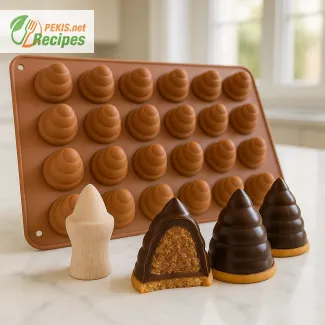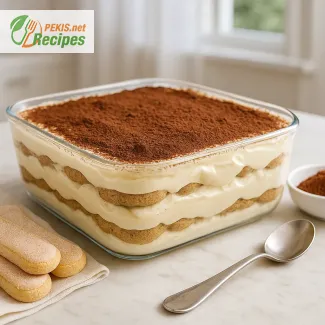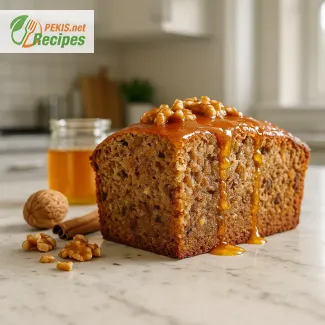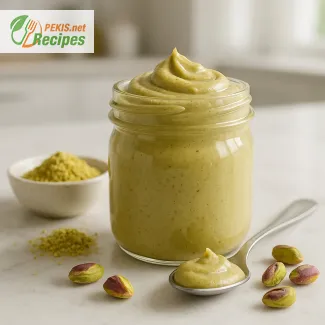Bratova Potica serves 10–12 slices and comes together in about 40 minutes of prep plus 45 minutes of baking, delivering a soft, golden Slovenian walnut roll filled with honey, cinnamon, and ground walnuts. The yeasted dough stays moist and tender, forming elegant spirals of flavor perfect for festive occasions. Its rich aroma deepens over time, and it keeps beautifully for up to 5 days at room temperature or 2 months frozen. A classic holiday centerpiece that balances sweetness, texture, and tradition in every slice.
There’s something deeply satisfying about shaping Bratova Potica—the way the dough turns silky under your hands and the scent of walnuts, honey, and butter slowly fills the kitchen. Years of working with traditional Slovenian pastries taught that the secret isn’t in rushing but in feeling the dough breathe, rise, and come alive. Watching the golden crust form in the oven still carries the same quiet joy every single time.
PEKIS – professional chef and recipe developer with over 25 years of experience in cooking and baking, specialized in European and international cuisine.
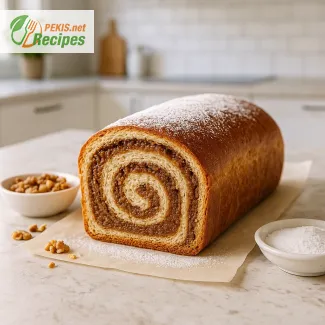
The Story Behind Bratova Potica
A festive Slovenian walnut roll that celebrates family tradition and craftsmanship
When the aroma of toasted walnuts, honey, and butter fills a Slovenian kitchen, it usually means that Bratova Potica is being baked — a cherished symbol of celebration and togetherness. This traditional walnut roll captures the essence of Slovenian holidays, where baking is more than a task; it’s an act of connection, warmth, and pride. Every layer of this soft, yeasted dough rolled with a rich nut filling tells a story of heritage, patience, and devotion to detail.
The name “Bratova Potica” translates to “Brother’s Potica”, a variation passed down through generations — each family adapting it slightly, yet preserving its heart: walnuts, honey, sugar, and a touch of cinnamon folded into buttery dough. Its rich golden crust hides a tender spiral inside, showcasing the care and time invested in every step. Unlike modern quick cakes, this one demands slow preparation — allowing the dough to rise naturally and the filling to soak in flavor — resulting in an authentic festive centerpiece for Easter, Christmas, or any family gathering.
The heritage and symbolism of Slovenian walnut rolls
Potica has been part of Slovenia’s cultural identity for centuries. Mentioned in 16th-century cookbooks, it was once prepared only for major holidays or weddings, symbolizing prosperity and unity. Every region developed its own variation — some with tarragon, others with honey or poppy seeds — but walnut potica remained the most beloved. Bratova Potica continues this legacy, keeping alive the art of homemade baking in a world where ready-made sweets often replace family recipes.
This dessert reflects Slovenian mountain and village life, where ingredients came straight from the farm: freshly milled flour, homemade butter, and hand-cracked walnuts. Its preparation was often a family affair — one kneading, another grinding nuts, someone else watching the oven with anticipation. Today, it still carries that sense of shared joy.
Why you’ll love this traditional walnut roll
- Rich and nutty flavor from freshly ground walnuts balanced by subtle sweetness.
- Soft, tender dough that stays moist even after baking.
- Beautiful swirled presentation perfect for holiday tables or gifts.
- Time-honored tradition that connects generations through baking.
- Versatile flavor that pairs beautifully with coffee, tea, or mulled wine.
Ingredient harmony and texture balance
The heart of Bratova Potica lies in its simple yet harmonious composition. Walnuts bring earthy depth and crunch; honey adds floral sweetness; eggs and butter enrich the dough, creating a smooth, elastic texture. A touch of lemon zest brightens the flavor, while cinnamon and vanilla lend warmth and aroma. The dough is gently rolled to achieve fine, even spirals, giving each slice its signature look.
Temperature and timing are key — letting the dough rest ensures the gluten relaxes, producing a soft crumb. The filling must be spread evenly to keep the layers balanced and avoid heavy patches. Once baked, the golden crust develops a slightly caramelized exterior while the interior remains tender and aromatic.
Creative variations of Bratova Potica
Although the walnut filling is classic, creative bakers often explore subtle twists:
- Honey-walnut and orange zest version for a citrusy aroma.
- Chocolate-hazelnut filling for a richer, modern touch.
- Tarragon and honey blend, a traditional Slovenian variant with herbal notes.
- Dried fruit addition, like raisins soaked in rum, for depth and sweetness.
- Mini potica rolls — individual servings that make charming holiday gifts.
Each version keeps the spirit of the original while adapting to modern tastes or available ingredients, proving that tradition and creativity can beautifully coexist in the kitchen.
Storage and make-ahead preparation
Bratova Potica keeps remarkably well when stored properly. Once cooled, it should be wrapped tightly in parchment paper and kept in an airtight container at room temperature for up to 5 days. The flavor deepens after a day or two as the walnut and honey mingle. For longer storage, it can be frozen for up to 2 months — simply thaw at room temperature and warm slightly before serving to restore its softness.
The dough and filling can be prepared one day ahead, refrigerated separately, and assembled just before baking. This makes it convenient for festive mornings when you want the scent of freshly baked potica without rushing through the process.
Discover more festive Slovenian cakes
If you love traditional Slovenian desserts layered with flavor and history, don’t miss the Prekmurska Gibanica Recipe – Traditional Slovenian Layer Cake — another national treasure combining walnuts, poppy seeds, apples, and cottage cheese in rich pastry layers.
Cultural significance and festive rituals
In Slovenia, potica isn’t merely dessert; it’s a ritual of celebration. It graces tables at Easter, Christmas, and weddings, often served with sparkling wine or warm herbal tea. Each family guards its own version, sometimes with handwritten notes passed down like heirlooms. For many Slovenians living abroad, baking potica is a way to reconnect with home — to recreate that warmth of Sunday gatherings and festive mornings where time slowed down, and stories were told over slices of fragrant walnut roll.
Even in modern kitchens, the process remains a moment of mindfulness: kneading the dough, spreading the filling, and watching it rise — all done with care. That’s what makes Bratova Potica more than just a recipe; it’s a culinary expression of love and belonging, embodying the timeless artistry of Slovenian baking.
- Activate the yeast: Warm the milk to about 35 °C (95 °F), add 1 teaspoon of sugar and crumble in the yeast. Let it rest for 10 minutes until it becomes frothy.
- Prepare the dough: In a large mixing bowl, combine flour, sugar, salt, lemon zest, melted butter, and eggs. Pour in the activated yeast mixture and knead for about 10 minutes until the dough becomes smooth and elastic.
- First rise: Cover the bowl with a clean kitchen towel and let the dough rise in a warm place for about 60 minutes, or until doubled in size.
- Prepare the walnut filling: In a saucepan, heat the milk and honey gently, then stir in ground walnuts, brown sugar, cinnamon, vanilla extract, and rum (optional). Mix well to create a thick, spreadable filling. Allow it to cool completely before using.
- Roll out the dough: On a lightly floured surface, roll the risen dough into a rectangle about 40 × 30 cm (16 × 12 inch). Spread the walnut filling evenly over the surface, leaving about 2 cm (¾ inch) at the edges.
- Form the roll: Carefully roll the dough from the longer side into a tight log, tucking the ends underneath to seal. Place it into a greased loaf or potica mold.
- Second rise: Cover again and let it rise for another 30–40 minutes.
- Bake: Preheat the oven to 180 °C (355 °F). Bake for 40–45 minutes until the crust turns deep golden brown and sounds hollow when tapped.
- Cool and finish: Allow the baked potica to rest in the mold for 10 minutes, then transfer to a wire rack to cool completely. Dust with powdered sugar before serving.
FAQ questionWhat makes Bratova Potica different from other walnut rolls?
Bratova Potica is a Slovenian festive walnut roll made with a soft, enriched yeast dough and a thick, aromatic walnut filling sweetened with honey and gently spiced with cinnamon and vanilla. Unlike simple nut strudels, it’s rolled to create even spirals, baked slowly, and served as a centerpiece for holidays. The filling is usually richer than in everyday nut breads, and the dough is buttery, fluffy, and elastic, which keeps the cake moist for days.
FAQ questionCan Bratova Potica be made in advance?
Yes. Because of the high ratio of walnuts, honey, and butter, this roll keeps well. It can be baked 1–2 days ahead, wrapped in parchment and stored at room temperature. The flavor even improves on day two as the filling soaks into the dough. For longer storage, it can be frozen for up to 2 months and gently reheated. This makes it ideal for Christmas, Easter, weddings, or when baking for guests.
FAQ questionWhy does the potica sometimes crack on top?
Cracking usually happens when the dough is rolled too tightly, when it didn’t rise long enough, or when the oven temperature is too high. The steam from the rich walnut filling needs room to escape. To prevent this, let the dough rise fully twice, spread the filling in a thin, even layer, and bake at 180 °C (355 °F). Even if it cracks slightly, the taste stays perfectly nutty and tender.
FAQ questionCan I change the filling or use other nuts?
Absolutely. The classic version uses walnuts, but you can swap them for hazelnuts, almonds, or a walnut-hazelnut mix. You can also add soaked raisins, orange zest, or rum for a more festive profile. What matters is keeping the filling spreadable, not runny, so the spirals stay neat. A too-wet filling will sink; a too-dry one will tear the dough.
FAQ questionHow do I make the dough really soft and not dry?
Use lukewarm milk, fresh yeast, and enough butter and egg yolks to enrich the dough. Knead until the dough is smooth, elastic, and slightly glossy. Let it rise in a warm, draft-free spot until doubled in size. A slow rise develops better flavor and texture. Brushing the baked potica with melted butter and dusting with powdered sugar helps keep the crust soft.
FAQ questionIs Bratova Potica suitable for gifting or serving at celebrations?
Yes, it’s one of the most traditional Slovenian celebration cakes. It slices beautifully, looks impressive with its spiral interior, and stays fresh for several days—ideal for family gatherings, holidays, baptisms, weddings, and Sunday lunches. Pack it in parchment and a box to keep the aroma and moisture. Recipients always appreciate something handmade, fragrant, and traditional.
FAQ questionWhat can I serve with Bratova Potica?
It pairs beautifully with coffee, black tea, mulled wine, or dessert wine. For brunch, it can be served with fresh fruit, whipped cream, or a light vanilla custard. Because it’s naturally rich and nutty, it works as both a dessert and a festive breakfast bread, especially around Christmas and Easter.
The comforting aroma of freshly baked Bratova Potica brings a sense of warmth that defines every Slovenian celebration. With its delicate, buttery dough and rich walnut filling, it captures both the artistry and heart of traditional baking. Every slice tells a story of family gatherings, patient preparation, and the joy of sharing something made with care.
Each roll of dough wraps around generations of culinary heritage, where precision meets emotion. The smooth layers of honey-sweetened walnuts and soft, golden crust create an unmistakable harmony of taste and texture. It’s a dessert that stands proudly among Europe’s finest festive pastries, bridging the gap between old-world tradition and timeless enjoyment.
When served at the table, Bratova Potica becomes more than a dessert—it’s a symbol of connection. The slow preparation invites reflection, while its flavor rewards the effort with every tender, fragrant bite. Whether shared during holidays or enjoyed on a quiet afternoon, its balance of sweetness, nuttiness, and softness never fails to delight.
A true celebration of craftsmanship and flavor, Bratova Potica embodies what makes Slovenian baking special: simple ingredients, perfected through patience, and remembered through generations. It’s a classic worth keeping in every baker’s repertoire—a taste of home that endures through time.
Allergens present in the recipe:
- Gluten – present in all-purpose flour.
- Milk – found in milk and butter.
- Eggs – used in the dough.
- Tree nuts (walnuts) – main ingredient of the filling.
Tips for replacing allergens and gluten:
- Replace wheat flour with gluten-free flour blend suitable for yeast doughs.
- Substitute cow’s milk with almond or oat milk for a lactose-free version.
- Use vegan butter or margarine instead of dairy butter.
- Replace eggs with flaxseed gel (1 tbsp ground flax + 3 tbsp water per egg).
- For nut allergies, use sunflower seeds or ground oats for a similar texture.
- Vitamin B1 (Thiamine) – 0.15 mg – supports energy metabolism.
- Vitamin E – 1.2 mg – helps protect cells from oxidative stress.
- Magnesium – 40 mg – contributes to muscle and nerve function.
- Calcium – 45 mg – supports bone and dental health.
- Iron – 1.3 mg – aids in red blood cell formation.
- Zinc – 0.9 mg – supports immune system and skin health.
- Polyphenols – 45 mg – help reduce oxidative stress.
- Melatonin (from walnuts) – 0.2 mg – promotes better sleep quality.
- Ellagic acid – 0.4 mg – supports cell protection and tissue repair.
- Beta-carotene – 0.1 mg – contributes to healthy vision and skin.
- Flavonoids – 30 mg – support cardiovascular and immune health.

